PRODUCT LIST FOR ION S5
Immuno-oncology
Oncomine™ Immune Response Research Assay:
Assay performance
Interpretation of immune surveillance and tumor progression mechanism with functional annotation of genes and pathways
Oncomine Immune Response Research Assay content includes 395 genes across 36 functional annotation groups. These groups are comprised of genes associated with lymphocyte regulation, cytokine signaling, lymphocyte markers, checkpoint pathways, and tumor characterization
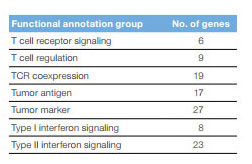
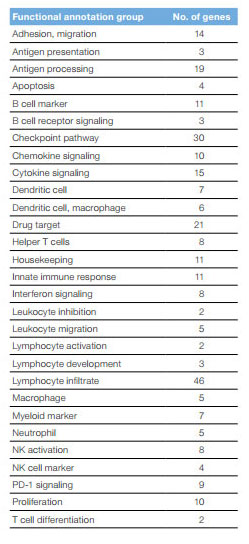
Oncomine™ Lung cfDNA Assay:
The Oncomine™ Lung cfDNA Assay is part of a complete research solution to detect lung tumor-derived DNA (ctDNA) in cfDNA.
– It provides the reagents for library construction and a single pool of multiplex PCR primers for preparation of amplicon libraries from cell-free DNA (cfDNA) obtained from the plasma fraction of a single tube of whole blood.
-The assay enables researchers to analyze single nucleotide variants and short indels that are frequently mutated in non-small cell lung cancer (NSCLC).
-Through the use of proprietary sequencing technology, a limit of detection (LOD) down to 0.1% can be achieved.
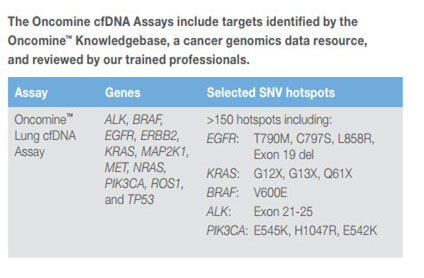
Oncomine™ BRCA Research Assay:
New to the Ion Torrent™ Oncomine™ family of products is the Oncomine™ BRCA Research Assay for the detection of BRCA somatic and germline mutations from formalin-fixed, paraffinembedded (FFPE) tissue and whole blood
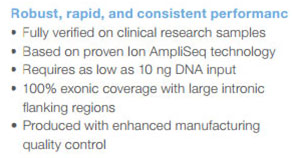
Oncomine™ Comprehensive Library Assay:
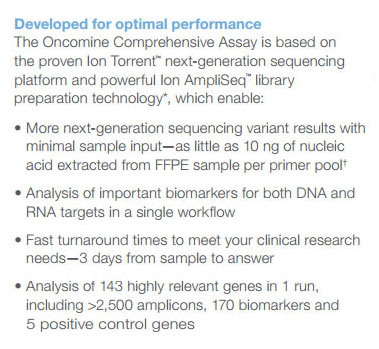
Oncomine™ Focus Assay:
A Solid Tumor Next Generation Sequencing Assay For Biomarker Analysis
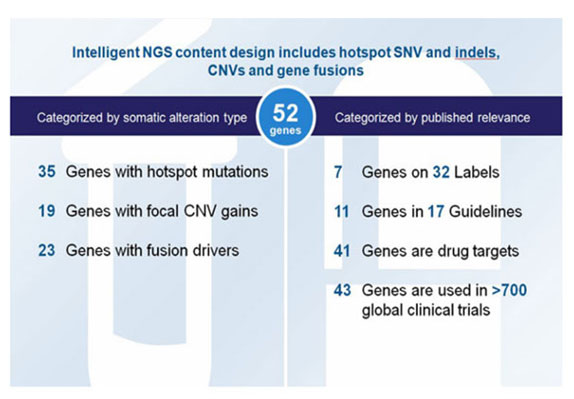

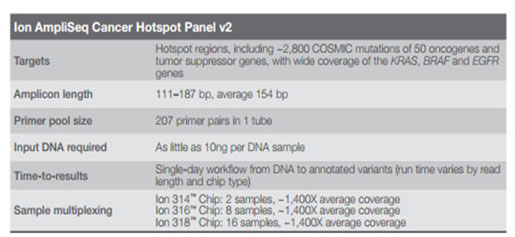
Oncomine™ Breast cfDNA Assay:
The Ion Torrent™ Oncomine™ Breast cfDNA Assay is a multi-biomarker next-generation sequencing (NGS) assay that enables detection of primary driver and resistance mutations from cell free DNA down to a level of 0.1%.
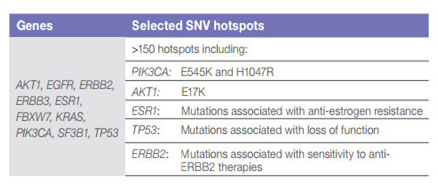
Oncomine™ Colon cfDNA Assay:
The Ion Torrent™ Oncomine™ Colon cfDNA Assay is a multibiomarker next-generation sequencing (NGS) assay that enables detection of primary driver and resistance mutations from cell-free DNA (cfDNA) down to a level of 0.1%.
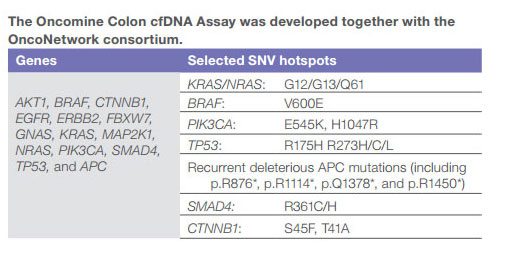
Ion AmpliSeq™ RNA Cancer Research Panel:
The panel is a single pool of primers targeting 50 oncogenes and tumor suppressor genes including the KRAS, BRAF, and EGFR genes. Ion AmpliSeq™ RNA Cancer Panel.
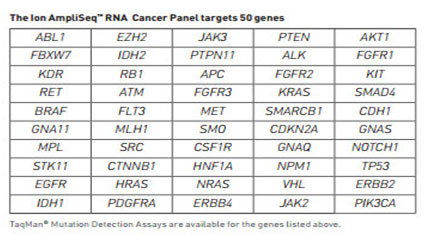
Ion AmpliSeq™ Transcriptome Human Gene Expression Kit:
Easy gene-level transcriptome sequencing The Ion AmpliSeq™ Transcriptome Human Gene Expression Kit with the Ion S5™ System enables fast and affordable gene expression analysis from limited or degraded samples, such as formalin-fixed, paraffin-embedded (FFPE) tissues (Figure 1). With simultaneous amplification of more than 20,000 RefSeq genes in a single tube starting from as little as 10 ng of total RNA, the Ion AmpliSeq Transcriptome Human Gene Expression Kit transforms cancer and translational research in tumor profiling and biomarker discovery

Whole transcriptome RNA-Seq
rRNA depletion: Invitrogen™ RiboMinus™ Eukaryote System v2:
The RiboMinus™ Eukaryote System v2 provides truly complete transcriptome isolation for next generation sequencing analysis by offering selective depletion of up to 99.9% of the cytoplasmic (5S, 5.8S, 18S, and 28S) and mitochondrial (12S and 16S) ribosomal RNA from total RNA.
– This selection system contrasts with poly-A and cap binding methods, which introduce bias and select for only part of the transcriptome.
The RiboMinus Eukaryote System v2 is designed for the removal of human, mouse, and rat rRNA. A magnetic bead-based purification module is included for purification of the whole transcriptome without altering the expression levels of small or non-coding RNA.
Ion Total RNA-Seq Kit v2:
The Ion Total RNA-Seq Kit v2 includes the reagents needed to prepare representative cDNA libraries for strand-specific RNA sequencing on the Ion Proton™ or the Ion Personal Genome Machine® (PGM™) systems.
The Ion Proton™ System is ideally suited for sequencing the whole transcriptome (ribosomal RNA depleted or polyA), while the Ion PGM™ System is suitable for small RNA, as well as viral and bacterial transcriptomes.
Either small RNA (such as microRNA) or whole transcriptome RNA samples can be prepared for next-generation sequencing using the Ion Total RNA-Seq Kit v2.
1) Cystic Fibrosis (deltaF508) CFTR mutation
- Cystic fibrosis (CF) is an autosomal recessive inherited genetic disease that is caused by mutations in the cystic fibrosis transmembrane conductance regulator (CFTR) gene. This test is performed by Peripheral Blood sample.
2) DMD (Duchenne Muscular Dystrophy) 26 exons
- Dystrophin is a member of the spectrin/alpha-actinin family of actin-binding, triple helix rod-containing proteins. This test is performed by Peripheral Blood sample and sequencing method.
3) DMD DUCHENNE MUSCULAR DYSTROPHY (18 exons)
- Staining of formalin-fixed tissues requires boiling tissue sections in 1 mM EDTA, pH 8.0 for 10 minutes followed by cooling at room temperature for 20 minutes. Positive control of skeletal muscle suggested. This test is performed by Peripheral Blood sample and sequencing method.
4) DMD DUCHENNE MUSCULAR DYSTROPHY- SEQUENCING
- Dystrophin is a member of the spectrin/alpha-actinin family of actin-binding, triple helix rod-containing proteins. This test is performed by Peripheral Blood sample and NGS method.
5) Progressive Familial Intrahepatic Cholestasis (PFIC1&2) Mutation Analysis
- The membrane-associated protein encoded by this gene is a member of the superfamily of ATP-binding cassette (ABC) transporters. ABC proteins transport various molecules across extra- and intra-cellular membranes. This test is performed by Peripheral Blood sample and NGS method.
6) Renal hypouricemia (SLC22A12 & SLC2A9) By Sanger Sequencing
- Our simple and fast Sanger sequencing workflow can be completed in less than one workday, from sample to answer. This test is performed by Peripheral Blood sample and sequencing method.
7) GILBERT SYNDROME
- Simplest method available to study copy number variation
- Assays available for common vector market and reporter genes
- Measure distinct copy number changes quantitatively with high specificity and reproducibility. This test is performed by Peripheral Blood sample and sequencing method.
8) GLYCOGEN STORAGE DISEASE PANEL BY NEXT GENERATION SEQUENCING
- The Applied Biosystems Precision ID NGS System for human identification can help you solve tough cases by getting more information from your challenging samples. This test is performed by Peripheral Blood sample and NGS method.
9) Haemochromatosis HFE Gene Mutation Analysis
- Research indicates that genetic variations are key for understanding the genetic basis of complex traits and diseases. Variants can influence phenotypes, the susceptibility of an individual to disease, drug response and human genome evolution. This test is performed by Peripheral Blood sample and sequencing method.
10) Hemochromatosis (HFE gene) Mutation Analysis (2 common mutations) by Sanger Sequencing
- Next-generation sequencing (NGS) analyses have revolutionized our understanding of biological processes. This test is performed by Peripheral Blood sample and sequencing method.
11) HEREDITARY FRUCTOSE INTOLERANCE (ALDOB GENE) MUTATION ANALYSIS BY NEXT GENERATION SEQUENCING
- Ion Torrent™ Technology directly translates chemically encoded information (A, C, G, T) into digital information (0, 1) on a semiconductor chip. This test is performed by Peripheral Blood sample and NGS method.
12) GALACTOSEMIA (GALT) MUTATION ANALYSIS BY NEXT GENERATION SEQUENCING
- The result is a sequencing technology that is simpler, faster, and more cost-effective and scalable than any other next-generation sequencing (NGS) technology available. This test is performed by Peripheral Blood sample and NGS method.
13) PHENYLKETONURIA (PKU) PAH GENE MUTATION ANALYSIS BY NEXT GENERATION SEQUENCING
- Ion Torrent™ next-generation sequencing supports many popular NGS applications, including targeted DNA, transcriptome, targeted RNA, and exome sequencing. This test is performed by Peripheral Blood sample and NGS method.
14) TYROSINEMIA FAH GENE MUTATION ANALYSIS BY NEXT GENERATION SEQUENCING
- From gold standard Sanger sequencing to simple and scalable Ion Torrent™ next-generation sequencing, we have a platform to meet your needs. This test is performed by Peripheral Blood sample and NGS method..
15) UREA CYCLE DISORDER PANEL BY NEXT GENERATION SEQUENCING
- This approach marries simple chemistry to proprietary semiconductor technology—it’s Watson meets Moore. The result is a sequencing technology that is simpler, faster, and more cost-effective and scalable than any other next-generation sequencing (NGS) technology available. This test is performed by Peripheral Blood sample and NGS method.
16) WILSON DISEASE (ATP7B GENE) MUTATION ANALYSIS BY NEXT GENERATION SEQUENCING
- From gold standard Sanger sequencing to simple and scalable Ion Torrent™ next-generation sequencing, we have a platform to meet your needs. This test is performed by Peripheral Blood sample and NGS method.
17) HUNTINGTON DISEASE MOLECULAR ASSAY
- The pathogenesis of Huntington’s Disease (HD) and other neurodegenerative disorders has been previously attributed to increases and decreases in components of the complement system. This test is performed by Peripheral Blood sample and NGS method.
18) SCA (SPINOCEREBELLAR ATAXIA) SINGLE FORM
- Slowly progressive ataxia accompanied by cerebellar degeneration is often genetic in origin. The past fifteen years have witnessed a revolution in our understanding of the causes of dominantly inherited ataxias, now known as the spinocerebellar ataxias (SCAs). This test is performed by Peripheral Blood sample and Sequencing method.
19) SCA PANEL
- The Ion AmpliSeq™ Comprehensive Cancer Panel provides highly multiplexed target selection of genes implicated in cancer research. This test is performed by Peripheral Blood sample and Sequencing method.
20) SMA (SPINAL MUSCULAR ATROPHY) (EXON 7&8 OF SMN1&2)
- Spinal muscular atrophy (SMA) is an autosomal recessive motor neuron disorder characterized by the degeneration of the anterior horn cells of the spinal cord. This test is performed by Peripheral Blood sample and Sequencing method.
21) SMA (SPINAL MUSCULAR ATROPHY) (EXON 7&8 OF SMN1&2) (PRENATAL)
- Spinal muscular atrophy (SMA) is characterized by muscle weakness and atrophy resulting from progressive degeneration and loss of the anterior horn cells in the spinal cord (i.e., lower motor neurons) and the brain stem nuclei. This test is performed by Chronic villie and Sequencing method.
22) HEREDITARY PANCREATITIS PANEL
- Hereditary pancreatitis (HP) is defined as 2 or more individuals in a family affected with pancreatitis involving at least 2 generations. The most common monogenic cause of HP is the presence of a mutation in the cationic trypsinogen (PRSS1)gene. This test is performed by Peripheral Blood sample and NGS method.
23) LYSOSOMAL STORAGE DISORDER PANEL BY NEXT GENERATION SEQUENCING
- Now, more laboratories can adopt powerful next-generation sequencing technology to get answers faster —with increased throughput, higher accuracy, and the simplest workflow from sample preparation through to data analysis. This test is performed by Peripheral Blood sample and NGS method.
24) DYT1 Dystonia
- Mutations in this gene result in the autosomal dominant disorder, torsion dystonia 1. This test is performed by Peripheral Blood sample and Sequencing method.
25) DYT11 (MYOCLONIC DYSTONIA) SGCE GENE MUTATION ANALYSIS
- Myoclonus‐dystonia (M‐D) is a hyperkinetic movement disorder, typically alcohol‐responsive upper body myoclonus and dystonia. This test is performed by Peripheral Blood sample and Sequencing method.
26) MAPLE SYRUP URINE DISEASE (MSUD) MUTATION ANALYSIS (4 GENE PANEL) BY NEXT GENERATION Sequencing
- Maple Syrup Urine Disease (MSUD) is a disorder of branched chain amino acid metabolism that is often classified by clinical phenotype as classic, intermediate or intermittent. This test is performed by Peripheral Blood sample and NGS method.
27) MAPLE SYRUP URINE DISEASE (MSUD) MUTATION ANALYSIS SINGLE GENE BY NEXT GENERATION SEQUENCING
- Individuals with intermediate MSUD have partial BCKAD enzyme deficiency that only manifests intermittently or responds to dietary thiamine therapy; these individuals can experience severe metabolic intoxication and encephalopathy during sufficient catabolic stress. This test is performed by Peripheral Blood sample and NGS method.
28) NGS Biochemical Panel
- Every case and every sample may have different analysis needs. You can choose the best solution from a variety of targeted Precision ID panels—whether you need high-resolution genotyping of STRs, SNP analysis to generate investigative leads based on biogeographic ancestry or phenotypic traits, or mitochondrial DNA analysis when there is no nuclear DNA present. This test is performed by Peripheral Blood sample and NGS method.
29) RMRP Gene Sequencing
- This gene encodes the RNA component of mitochondrial RNA processing endoribonuclease, which cleaves mitochondrial RNA at a priming site of mitochondrial DNA replication. This test is performed by Peripheral Blood sample and NGS method.
30) VHL (von Hippel Lindau) Mutation Assay
- The theoretical molecular weight of VHL is 24 kDa. However, different migrating species ranging from 21-30 kDa have been observed using antibodies to VHL, and may result from a variety of factors including alternatively spliced VHL mRNAs and protein degradation. This test is performed by Peripheral Blood sample and NGS method.
31) FACTOR II MUTATION
- Research indicates that genetic variations are key for understanding the genetic basis of complex traits and diseases. Variants can influence phenotypes, the susceptibility of an individual to disease, drug response and human genome evolution. This test is performed by Peripheral Blood sample and Real Time PCR method.
32) FACTOR V MUTATION
- Coagulation factor V (or Proaccelerin) is an essential factor of the blood coagulation cascade. This factor circulates in plasma, and is converted to the active form by the release of the activation peptide by thrombin during coagulation. . This test is performed by Peripheral Blood sample and Real Time PCR method.
33) RETT SYNDROME
- DNA methylation is crucial for normal embryonic development, imprinting, and X-chromosome inactivation. Methyl CpG binding proteins (MeCPs) specifically recognize methylated regions of DNA and repress transcription both directly and by association with known corepressor proteins which include members of the Sin3 and histone deactylase protein families. This test is performed by Peripheral Blood sample and Sequencing method.
34) FLT3 MUTATION
- This gene encodes a class III receptor tyrosine kinase that regulates hematopoiesis. This receptor is activated by binding of the fms-related tyrosine kinase 3 ligand to the extracellular domain, which induces homodimer formation in the plasma membrane leading to autophosphorylation of the receptor. This test is performed by Peripheral Blood sample / Bone marrow and Real Time PCR method.
35) Bacterial Identification By Sequencing
- Torrent Suite Software provides the tools that take you from raw sequence data to informative results, including optimized signal processing, base calling, sequence alignment, and variant analysis. This test is performed by Culture colonies and Sequencing method.
36) HLA – A
- HLA-A belongs to the HLA class I heavy chain paralogues. This class I molecule is a heterodimer consisting of a heavy chain and a light chain (beta-2 microglobulin). The heavy chain is anchored in the membrane. This test is performed by Peripheral Blood Sample and Sequencing method.
37) HLA – B
- The heavy chain is anchored in the membrane. Class I molecules play a central role in the immune system by presenting peptides derived from the endoplasmic reticulum lumen. They are expressed in nearly all cells. This test is performed by Peripheral Blood Sample and Sequencing method.
38) HLA – C
- HLA-C belongs to the HLA class I heavy chain paralogues. This class I molecule is a heterodimer consisting of a heavy chain and a light chain (beta-2 microglobulin). The heavy chain is anchored in the membrane. This test is performed by Peripheral Blood Sample and Sequencing method.
39) HLA – DQ
- This SK10 monoclonal antibody reacts with the human MHC Class II HLA-DQ molecule. This cell surface receptor is a heterodimeric protein composed of an alpha (HLA-DQA1) and beta (HLA-DQB1) subunit. HLA-DQ is expressed on antigen presenting cells such as B cells, monocytes, macrophages, dendritic cells, and activated T cells. This test is performed by Peripheral Blood Sample and Sequencing method.
40) HLA DQ HIGH RESOLUTION
• Provides low to intermediate HLA typing results
• Products offered in a variety of formats, including combo kits
• Quick turn-around-time makes this technology ideal for on-call typing
This test is performed by Peripheral Blood Sample and Sequencing method.
41) HLA – DR
- HLA-DRB1 belongs to the HLA class II beta chain paralogs. The class II molecule is a heterodimer consisting of an alpha (DRA) and a beta chain (DRB), both anchored in the membrane. It plays a central role in the immune system by presenting peptides derived from extracellular proteins. This test is performed by Peripheral Blood Sample and Sequencing method.
42) HLA A,B & DR
- Heat-mediated antigen retrieval using a sodium citrate buffer (pH 6.0) is recommended for the staining of paraffin sections. A suggested positive control for immunohistochemical applications is tonsil. This test is performed by Peripheral Blood Sample and Sequencing method.
43) HLA A,B,C,DR & DQ
- The human MHC class II molecules bind intracellularly processed peptides and present them to T-helper cells. They therefore have a critical role in the initiation of the immune response. This test is performed by Peripheral Blood Sample and Sequencing method.
44) HLA Typing For Class I And Class II (HLA A, B, C, DR & DQ) HIGH RESOLUTION
- The product is supplied in an acqueous suspension of phosphate buffered saline (PBS) containing 0.1% bovin serum albumin (BSA) and 0.02% sodium azide. This test is performed by Peripheral Blood Sample and Sequencing method.
45) HLA Typing For Class I And Class II (HLA A, B, DR ) HIGH RESOLUTION
- Long acknowledged as the gold standard for genetic analysis, automated multicolor fluorescent sequencing is now accepted as the definitive method for high-resolution HLA typing research. This test is performed by Peripheral Blood Sample and Sequencing method.
46) Inherited Disease Panel
- Developed to match genes targeted by clinical molecular geneticists studying inherited diseases, including genes listed in the NIH Genetic Testing Registry, the Ion AmpliSeq™ Inherited Disease Panel employs over 10,000 primer pairs in just 3 tubes to amplify the exons of 328 genes. This test is performed by Peripheral Blood Sample and NGS method.
47) Y – STR
- Blood and buccal samples on treated paper substrates, without the need for sample purification. Blood samples collected on untreated paper substrates and treated with Prep-n-Go™ Buffer. This test is performed by Peripheral Blood Sample and Sequencing method.
48) CYP2D6 (CYTOCHROME P450 2D6) ALLELES
• Single human P450 isozyme for detailed drug metabolism studies
• High specific activity increases dynamic range and sensitivity
• No background metabolism for clear results. This test is performed by Peripheral Blood Sample and Sequencing method.
49) ACUTE LEUKEMIA MINI PANEL
- In general, cell lines are considered to be genetically and phenotypically homogenous populations of cells. When cell lines are cultured in vitro, the most adaptable clone is usually the one that expands most rapidly during the stabilization process, and the cells derived from this clone become the most abundant in the culture. This test is performed by Peripheral Blood Sample / Bone Marrow and Real Time PCR method.
50) ALL PCR PANEL
- The Applied Biosystems™ Precision ID mtDNA Whole Genome Panel is an innovative next-generation sequencing (NGS) approach to mitochondrial DNA (mtDNA) analysis specifically developed for forensic applications. This test is performed by Peripheral Blood Sample / Bone Marrow and Real Time PCR method.
51) AML PCR PANEL
- Based on ultrahigh-multiplex PCR, Ion AmpliSeq technology requires as little as 1 ng of input DNA to target sets of genes, making sequencing of FFPE samples routine on Ion PGM™ or Ion S5™ systems. This test is performed by Peripheral Blood Sample / Bone Marrow and Real Time PCR method.
52) BETA GLOBIN GENE SEQUENCING
- The GLOBINclear™-Human Kit uses a novel, non-enzymatic technology that rapidly depletes >95% of the alpha and beta globin mRNA from total RNA preparations derived from whole blood. This test is performed by Peripheral Blood Sample and Sequencing method.
53) BETA THALASSEMIA (23 Mutations)
- Beta-thalassemia is characterized by a reduced production of hemoglobin A which results from the reduced synthesis of beta-globin chains relative to alpha-globin chains, thus causing an imbalance in globin chain production and hence abnormal erythropoiesis. The disorder is clinically heterogeneous. This test is performed by Peripheral Blood Sample and Sequencing method.
54) BETA THALASSEMIA (5 Common Mutation)
- Beta-thalassemia (β-Thal), is the most frequently observed hereditary blood disorder in the world and is characterized by deficiency of hemoglobin β-globin gene [1]. In the case of β-Thal, there is reduced (β+ type) or absent (βo type) synthesis of the beta chains of hemoglobin [1, 2]. This test is performed by Peripheral Blood Sample and Sequencing method.
55) CALRETICULIN (CALR) MUTATION ASSAY)
- Immunofluorescent analysis of Calreticulin (green) U2OS cells. Formalin fixed cells were permeabilized with 0.1% Triton X-100 in PBS for 10 minutes at room temperature and blocked with 2% BSA in PBS 0.1% triton-X (Product #37525) for 30 minutes at room temperature. This test is performed by Peripheral Blood Sample/Bone Marrow and Sequencing method.
56) CEBPA MUTATION STUDY
- This intronless gene encodes a transcription factor that contains a basic leucine zipper (bZIP) domain and recognizes the CCAAT motif in the promoters of target genes. The encoded protein functions in homodimers and also heterodimers with CCAAT/enhancer-binding proteins beta and gamma. This test is performed by Peripheral Blood Sample and Sequencing method.
57) IMATINIB RESISTANCE MUTATION ANALYSIS
- Imatinib is a Tyrosine kinase inhibitor (TKI) capable of inducing durable hematologic and cytologic remissions in patients with Chronic Myeloid Leukemia (CML). This test is performed by Peripheral Blood Sample and Sequencing method.
58) JAK 2 MUTATION PANEL (EXONS 12,15)
- This gene product is a protein tyrosine kinase involved in a specific subset of cytokine receptor signaling pathways. It has been found to be constituitively associated with the prolactin receptor and is required for responses to gamma interferon. This test is performed by Peripheral Blood Sample/Bone Marrow and Real Time PCR method.
59) JAK 2 Mutation Study
- Janus kinase 2 (JAK2) is a protein tyrosine kinase involved in a specific subset of cytokine receptor signaling pathways and is mutated in polycythemia vera. This kinase contains the catalytic domain (JH1) of JAK2. This test is performed by Peripheral Blood Sample/Bone Marrow and Real Time PCR method.
60) MAJOR BCRABL
- Philadelphia chromosome or Philadelphia translocation is a specific chromosomal abnormality that is associated with chronic myelogenous leukemia (CML). It is the result of a reciprocal translocation between chromosome 9 and 22, and is specifically designated t(9;22)(q34;q11).BCR-ABL transcripts e19-a2 and b3a3 are form present only in rare cases.95% of people with CML have this abnormality. This test is performed by Peripheral Blood Sample/Bone Marrow and Real Time PCR method.
61) Major BCR-ABL Fusion-Transcript Detection ( Qual)
- Chromosome translocations are abnormalities caused by rearrangement of chromosome sections between nonhomologous chromosomes. These rearrangements may result in chimeric genes that express fusion transcripts. This test is performed by Peripheral Blood Sample/Bone Marrow and Real Time PCR method.
62) MINOR BCRABL
- One of the known causes of cancer are translocations that create fusion transcripts that result in altered protein expression. This test is performed by Peripheral Blood Sample/Bone Marrow and Real Time PCR method.
63) MYELOPROLIFERATIVE LEUKEMIA (MPL 1)
- In 1990 an oncogene, v-mpl, was identified from the murine myeloproliferative leukemia virus that was capable of immortalizing bone marrow hematopoietic cells from different lineages. This test is performed by Peripheral Blood Sample/Bone Marrow and Sequencing method.
64) NPM1 MUTATION
- Nucleophosmin (NPM; also known as B23, numatrin or NO38) is a highly conserved phosphoprotein that belongs to nucleoplasmin/nucleophosmin family of nuclear chaperones. Expressed ubiquitously with nucleolar localization, NPM shuttles between nucleoli and cytoplasm during cell cycle progression. This test is performed by Peripheral Blood Sample and Sequencing method.
65) PML RARA Fusion Gene Detection (Qualitative)
- Promyelocytic leukemia (APL or AML-M3) is a subtype of acute myeloid leukemia with distinct clinical and histopathologic features.Genetically, APL is characterized by a unique chromosomal anomaly. This test is performed by Peripheral Blood Sample/Bone Marrow and Real Time PCR method.
66) PML RARA Fusion Gene Detection (Quantitative)
- One of the known causes of cancer are translocations that create fusion transcripts that result in altered protein expression. This test is performed by Peripheral Blood Sample/Bone Marrow and Real Time PCR method.
67) Warfarin Genotyping
- Warfarin is the most frequently prescribed oral anticoagulant drug used for the prevention of, and treatment of individuals with, thromboembolic perturbances. This test is performed by Peripheral Blood Sample and Sequencing method.
68) BK/JC POLYOMA VIRUS
- Limitations preventing the development of novel therapies for JCV include the lack of an animal model and difficulties to determine antiviral activity of potential drugs in vitro. Current techniques consist of measurement of JC viral load in cells and supernatant as well as expression of JCV VP1 protein, which are labour intensive and require harvesting of samples at various time points. This test is performed by Peripheral Blood Sample/Urine and Real Time PCR method.
69) AMYOTROPHIC LATERAL SCLEROSIS (SOD1) BY NEXT GENERATION SEQUENCING
- Ion Torrent™ Technology directly translates chemically encoded information (A, C, G, T) into digital information (0, 1) on a semiconductor chip. This approach marries simple chemistry to proprietary semiconductor technology—it’s Watson meets Moore. This test is performed by Peripheral Blood Sample and NGS method.
70) PGS FOR 3 EMBRYOS (Extended)
- Aneuploidy can now be detected via next-generation sequencing (NGS) using DNA from a single or multiple cells isolated from preimplantation embryos. This test is performed by NGS method.
71) PGS FOR 4 EMBRYOS (Extended)
- The Ion ReproSeq™ PGS View Kit on the Ion PGM™ System delivers the fastest and most affordable NGS workflow for reliable aneuploidy detection of all 24 chromosomes in preimplantation embryos. Click on the button below to get a quote for the complete Ion ReproSeq PGS View solution. This test is performed by NGS method.
72) PGS FOR 5 EMBRYOS (Extended)
- On-demand aneuploidy analysis and minimized sample batching enabled by a cost-effective workflow that scales to your throughput needs. This test is performed by NGS method.
73) PRENATAL BETA THALASSEMIA
- About 200 causative mutations are characterized in the β-globin gene. Beta thalassemia diagnosis is very complicated due to the genetic diversity of HBB gene across different geographical regions of the world. This test is performed by Chronic Villi and Real Time PCR method.
74) PRENATAL CUSTOM GENETIC SCREENING
- Faster access to reliable data allows you to move more quickly through compound profiling projects and ultimately speeds your discovery efforts. This test is performed by NGS method.
75) PRENATAL SICKLE CELL DISEASE
- Gibco® AmnioMAX™ – II Complete Medium is a fully-supplemented medium developed for the short term culture of human amniotic fluid cells for cytogenetic studies and in vitro diagnostic procedures. This test is performed by Chronic Villi and Real Time PCR method.
76) Sperm DNA Fragmentation study
- UltraPure™ Salmon Sperm DNA Solution is a ready-to-use, sheared DNA solution that is used directly in the preparation of prehybridization and hybridization solutions. This test is performed by Semen and Gel PCR method.
77) Y-Chromosomal Microdeletion
- Some infertile men with azoospermia or severe oligospermia have small deletions in regions of the Y chromosome. This test is performed by Peripheral Blood Sample method.
78) ALK MUTATION
- Immunohistochemistry analysis of ALK showing staining in the cytoplasm of paraffin-embedded human skeletal muscle tissue (right) compared to a negative control without primary antibody (left). This test is performed by Tumour Tissue method.
79) BRAF
- This gene encodes a protein belonging to the raf/mil family of serine/threonine protein kinases. This protein plays a role in regulating the MAP kinase/ERKs signaling pathway, which affects cell division, differentiation, and secretion. This test is performed by Tumour Tissue and Sequencing method.
80) BRCA 1&2
- The Ion AmpliSeq™ BRCA1 and BRCA2 Panel contains primer pairs that target the coding regions of the tumor suppressor genes BRCA1 and BRCA2, which have been implicated in hereditary breast and ovarian cancers. This test is performed by Peripheral Blood Sample and NGS method.
81) BRCA INDIA INITIATIVE (BRCA1&2 BY NEXT GENERATION SEQUENCING)
- Ion Torrent™ Technology directly translates chemically encoded information (A, C, G, T) into digital information (0, 1) on a semiconductor chip. This test is performed by Peripheral Blood Sample and NGS method.
82) cKIT & PDGFR (GASTROINTESTINAL STROMAL TUMORS)
- Molecular Analysis of PDGFRA and PDGFRB Genes by Rapid Single-strand Conformation Polymorphism (SSCP) in Patients with Core-binding Factor Leukaemias with KIT or FLT3 Mutation. This test is performed by Tumour Tissue Sample and Sequencing method.
83) cKIT (GASTROINTESTINAL STROMAL TUMORS) EXONS 9, 11, 13, 17
- Gastrointestinal stromal tumors (GISTs) strongly express a receptor tyrosine kinase (RTK, c-KIT-CD117) harboring a KIT mutation that causes constitutive receptor activation leading to the development and growth of tumors; 35% of GISTs without KIT mutations have platelet-derived growth factor receptor alpha (PDGFRA) mutations, and the type of mutation plays an important role in the response to treatment. This test is performed by Tumour Tissue Sample and Sequencing method.
84) Colon Cancer Panel ( NGS)
- Hotpots, SNVs, indels, CNVs, and gene fusions from DNA and RNA in a single workflow.Content driven by the Oncomine Knowledgebase and industry experts helps assure coverage of key targets aligned to approved therapies and indications. This test is performed by Tumour Tissue Sample and NGS method.
85) EGFR by NGS
- Thermo Fisher Scientific offers end-to-end solutions to help you make the most of limited material in liquid biopsy cancer research. This test is performed by Tumour Tissue Sample and NGS method.
86) GERM LINE CANCER PANEL
- With next generation sequencing (NGS) you can analyze your sample for hundreds of variants of interest using a single sample in a single experiment. You can detect hotspots, SNVs, indels, CNVs and gene fusions in a single run. This test is performed by NGS method.
87) IDH1&2 MUTATION DETECTION BY SEQUENCING
- The TaqMan™ Mutation Detection IPC Reagent Kit is a set of optional internal positive control reagents that can be duplexed with any TaqMan Mutation Detection Assay to provide a positive PCR control result. The TaqMan Mutation Detection IPC Reagent Kit is pre-optimized for use with the TaqMan Mutation Detection Assays.
88) KRAS MUTATION DETECTION BY SEQUENCING
- This gene, a Kirsten ras oncogene homolog from the mammalian ras gene family, encodes a protein that is a member of the small GTPase superfamily. A single amino acid substitution is responsible for an activating mutation. This test is performed by Tumour Tissue Sample and Sequencing method.
89) Lung Cancer Panel ( NGS)
- The Oncomine™ Lung cfDNA Assay is part of a complete research solution to detect lung tumor-derived DNA (ctDNA) in cfDNA. This test is performed by Tumour Tissue Sample and NGS method.
90) MGMT METHYLATION ASSAY
- Immunofluorescence analysis of MGMT (MT23.2) was performed using 70 % confluent log phase MCF7 cells. The cells were fixed with 4% paraformaldehyde for 10 minutes, permeabilized with 0.1% Triton™ X-100 for 10 minutes, and blocked with 1% BSA for 1 hour at room temperature. This test is performed by Tumour Tissue Sample and Sequencing method.
91) Microsatellite Instability
- Microsatellite instability (MSI) is a form of genomic instability due to reduced fidelity during the replication of repetitive DNA. This test is performed by Tumour Tissue/Peripheral Blood Sample and Sequencing method.
92) NGS CANCER HOTSPOT PANEL
- The Ion AmpliSeq™Cancer Hotspot Panel v2 is designed to amplify 207 amplicons covering approximately 2,800 COSMIC mutations from 50 oncogenes and tumor suppressor genes.
This test is performed by Tumour Tissue Sample and NGS method.
93) NRAS MUTATION ANALYSIS (20 SNPs)
- Sensitive detection of low-frequency mutant alleles has extensive implications for cancer research. The accumulation of mutations in oncogenes or tumor suppressor genes is an important aspect of tumorigenesis. This test is performed by Tumour Tissue Sample and Sequencing method.
94) PDGFR (GASTROINTESTINAL STROMAL TUMORS) EXONS 12, 14,18
- Gastrointestinal stromal tumor (GIST) has an estimated annual incidence in the US of approximately 3,000–4,000, making it the most common primary mesenchymal tumors of the gastrointestinal tract [1, 2]. This test is performed by Tumour Tissue Sample and Sequencing method.
95) PIK3CA MUTATION ANALYSIS (4 MUTATIONS)
- Phosphatidylinositol 3-kinase is composed of an 85 kDa regulatory subunit and a 110 kDa catalytic subunit. This test is performed by Tumour Tissue Sample and Sequencing method.
96) Human Gene 2.0ST and WT PLUS KIT
- The GeneChip™ Human Gene 2.0 ST Array provides the most accurate, sensitive, and comprehensive measurement of protein coding and long intergenic non-coding RNA transcripts.
97) Human Gene 1.0ST and WT PLUS KIT
- The GeneChip™ Human Gene 1.0 ST Array provides the most accurate, sensitive, and comprehensive measurement of protein coding and long intergenic non-coding RNA transcripts. We also offer the GeneChip Human Gene 2.0 ST Array, which can measure differential expression of long intergenic non-coding RNA transcripts.
98) Human Exon 1.0ST and WT PLUS KIT
- The GeneChip Exon Array is the most powerful whole-genome expression tool available today. With more than 5.5 million features on each array and the greatest single-array coverage of the transcriptome, including empirically supported and predicted transcripts, the Exon 1.0 ST Array maximizes your ability to identify known and novel alternative splicing events in addition to measuring expression of the entire transcriptome.
99) Human Gene 2.0ST and SSP WT KIT
- The GeneChip® Gene 1.0 ST Array System offers the most advanced and cost-effective gene expression profiling option for wholetranscript coverage. Probes are distributed across the full length of the gene, providing a more complete and accurate picture of overall gene expression.
100) Human Gene 1.0ST and SSP WT KIT
- The GeneChip™ Mouse Gene 1.0 ST Array is a whole-transcript array that includes probes to measure both messenger (mRNA) and long intergenic non-coding RNA transcripts (lincRNA). This whole-transcript array design provides a complete expression profile of mRNA as well as the intermediary lincRNA transcripts that impact the mRNA expression profile.
101) Human Exon 1.0ST and SSP WT KIT
- With approximately four probes per exon and roughly 40 probes per gene, the GeneChip™ Human Exon 1.0 ST Array enables two complementary levels of analysis—gene expression and alternative splicing. Multiple probes per exon enable “exon-level” analysis and allow you to distinguish between different isoforms of a gene. This exon-level analysis on a whole-genome scale opens the door to detecting specific alterations in exon usage that may play a central role in disease mechanism and etiology.
102) GeneChip R Human Transcriptome Array 2.0
- Designed to empower next-generation expression profiling studies, GeneChip™ Human Transcriptome Array 2.0 provides the ability to go beyond gene-level expression profiling by providing the coverage and accuracy required to accurately detect all known transcript isoforms produced by a gene.
103) GeneChip R Human Gene 2.0 ST Array
- Keeping pace with the research community’s understanding of the transcriptome, we have designed whole-transcript arrays that include probes to measure both messenger (mRNA) and long intergenic non-coding RNA transcripts (lincRNA).
104) GeneChip Human Tiling 2.0 R Array Set
- These library file updates are intended for use with the Tiling Analysis Software (TAS) Suite used to analyze the GeneChip™ Tiling Arrays. For more information on TAS or to obtain the most recent version of TAS, please refer to the Tiling Analysis Software support page.
105) GeneChip Human Tiling 1.0 R Array Set
- With the completion of many wholegenome sequences, new types of genomewide experiments are now possible. Tiling Arrays offer a physical readout of a genome and can be used as a discovery tool for mapping sites of protein/DNA interaction in chromatin immunoprecipitation (ChIP) experiments, discovering new RNA transcripts, or understanding global epigenomic changes like methylation or acetylation
106) GeneChip Human Promoter 1.0 R Array
• 35,685 ENSEMBL genes (version 21_34d, May 14, 2004)
• 25,172 RefSeq mRNAs (NCBI GenBank™, February 7, 2004)
• 47,062 complete-CDS mRNA (NCBI GenBank, December 15, 2003)
107) Mouse Gene 2.0 ST and WT PLUS Kit
- Since the design of the GeneChip Mouse Gene 1.0 ST Array, there has been a substantial increase in the structural and functional understanding of the mouse genome. This increase in knowledge includes the identification of a large number of long intergenic lincRNA that have been identified by the research community.
108) Mouse Gene 1.0 ST and WT PLUS Kit
- The GeneChip® Gene 1.0 ST Array System offers the most advanced and cost-effective gene expression profiling option for wholetranscript coverage. Probes are distributed across the full length of the gene, providing a more complete and accurate picture of overall gene expression.
109) Mouse Exon 1.0 ST and WT PLUS Kit
- The GeneChip Exon Array is the most powerful whole-genome expression tool available today. With more than 5.5 million features on each array and the greatest single-array coverage of the transcriptome, including empirically supported and predicted transcripts, the Exon 1.0 ST Array maximizes your ability to identify known and novel alternative splicing events in addition to measuring expression of the entire transcriptome
110) MTA 1.0 and WT PLUS reagents , 10 Samples
- With approximately four probes per exon and roughly 40 probes per gene, the GeneChip® Mouse Exon 1.0 ST Array enables two complementary levels of analysis—gene expression and alternative splicing.Multiple probes per exon enable “exon-level” analysis and allow you to distinguish between different isoforms of a gene.
111) MTA 1.0 and WT PLUS reagents , 30Samples
• Regulation of mRNA transcription
• Regulation of mRNA post-transcriptional modifications
• Occlusion/recruitment of transcription factor binding
• Activation and transportation of transcription factors
• Interaction with accessory proteins
• Guide protein complexes to locations in the genome
112) Gene Chip R Mouse Gene 2.0 ST Array
- The GeneChip™ Mouse Gene 2.0 ST Array is a whole-transcript array that includes probes to measure both messenger (mRNA) and long intergenic non-coding RNA transcripts (lincRNA). This whole-transcript array design provides a complete expression profile of mRNA as well as the intermediary lincRNA transcripts that impact the mRNA expression profile..
113) Gene Chip R Mouse Gene 1.0 ST Array
- Research over the past 20 years has predominantly focused on protein-coding messenger RNA transcripts and their role in cellular processes, such as disease and development. Recently researchers have identified more that 2,000 transcripts (>200 bases) in the mouse genome with little or no protein coding potential. Only a small fraction of these non-coding RNAs has functional annotations to date.
114) Gene Chip R Mouse Genome 430 2.0
- GeneChip® Mouse Genome 430 2.0 Array (single array, cartridge format) – Analyze gene expression across the entire mouse genome for one sample • GeneChip® Mouse Genome 430A 2.0 Array (single array, cartridge format) – Analyze gene expression of the most well-characterized genes in the mouse genome for one sample • GeneChip® HT Mouse Genome 430 Array Plate Set (multiple arrays, plate format) – Analyze gene expression across the entire mouse genome for up to 96 samples at a time.
115) Gene Chip R Mouse Exon 1.0 ST Array
- The GeneChip Exon Array is the most powerful whole-genome expression tool available today. With more than 5.5 million features on each array and the greatest single-array coverage of the transcriptome, including empirically supported and predicted transcripts, the Exon 1.0 ST Array maximizes your ability to identify known and novel alternative splicing events in addition to measuring expression of the entire transcriptome.
116) GeneChip R Mouse Tiling 2.0R Array Set
- These library file updates are intended for use with the Tiling Analysis Software (TAS) Suite used to analyze the GeneChip™ Tiling Arrays. For more information on TAS or to obtain the most recent version of TAS, please refer to the Tiling Analysis Software support page.At product introduction, tiling arrays are released with analysis information corresponding to the most current genome releases available.
117) GeneChip R Mouse Tiling 1.1R Array Set
- These library file updates are intended for use with the Tiling Analysis Software (TAS) Suite used to analyze the GeneChip™ Tiling Arrays. For more information on TAS or to obtain the most recent version of TAS, please refer to the Tiling Analysis Software support page.At product introduction, tiling arrays are released with analysis information corresponding to the most current genome releases available.
118) GeneChip R Mouse Promoter 1.0R Array Set
- Sequences used in the design of the Mouse Promoter 1.0R Array were selected from NCBI version 33 of the mouse genome. Repetitive elements were removed by RepeatMasker. Promoter regions were selected using sequence information from 33,559 ENSEMBL genes (version 30_33f March 23, 2005), 18,167 RefSeq mRNAs (NCBI GenBank® April 7, 2005), and 27,707 complete-CDS mRNAs (NCBI GenBank® April 7, 2005).
119) Rat Gene 2.0 ST and WT PLUS Kit
- The GeneChip™ Rat Gene 2.0 ST Arrays and GeneChip WT PLUS Reagent Kit offers a unique feature not available in other microarrays. Unlike traditional array designs that rely on a probe(s) designed to the first exon of the gene’s 3′ end, the hundreds of thousands of probes in this array are designed to every exon of every transcript represented on the array.
120) Rat Gene 1.0 ST and WT PLUS Kit
- The GeneChip® Gene 1.0 ST Array System offers the most advanced and cost-effective gene expression profiling option for wholetranscript coverage. Probes are distributed across the full length of the gene, providing a more complete and accurate picture of overall gene expression. Most 3’-based expression.
121) GeneChip R Rat Transcriptome Array 1.0
- Alternative splicing at the 3’ end of the gene • Utilization of a novel 3’ terminal exon • Alternative polyadenylation sites • Nonpolyadenylated messages • Truncated transcript • Degraded samples • Genomic deletions
122) Rat Exon 1.0ST and WT PLUS Kit
- We understand that rats are an important model organism commonly used for studying human disease. In order to keep your experiments relevant to the understanding of the transcriptome, we have designed an array based on the most recent genome content for generating genome-wide expression profiles.
123) GeneChip R Rat Gene 2.0 ST Array
- The GeneChip™ Rat Gene 2.0 ST Array offers a unique feature not available in other microarrays. Unlike traditional array designs that rely on a probe(s) designed to the first exon of the gene’s 3′ end, the hundreds of thousands of probes in this array are designed to every exon of every transcript represented on the array.
124) GeneChip R Rat Genome 230 2.0 Array
- • Provides comprehensive coverage of the transcribed rat genome on a single array
• Comprised of more than 31,000 probe sets, analyzing over 30,000 transcripts and variants from over 28,000 well-substantiated rat genes
• Sophisticated bioinformatics tools available through the NetAffx™ Analysis Center to rapidly obtain biologically meaningful results
• Publicly available drafts of the rat genome and leading public rat databases were used to refine sequences and provide a higher quality of data output
125) GeneChip R CHO Gene 2.0 ST Array
- The Chinese hamster ovary (CHO) cell lines were introduced in the 1960-s and has become an extremely important tool for biomedical research biopharmaceutical manufacturing. Their rapid growth, stable gene expression profiles, and high protein production make them idea for both research studies and for the production of therapeutic proteins.
126) Affymetrix R Arabidopsis Gene 1.0 ST Array
- The GeneChip™ Arabidopsis Gene 1.0 ST Arrays enable you to:
• Measure expression, across the entire gene, with higher resolution and accuracy than with classical 3′-biased microarray solutions
• Get accurate and reproducible data by using multiple independent measurements for each transcript
127) Affymetrix R Bovine Gene 1.0 ST Array
- The GeneChip™ Bovine Gene 1.0 ST Arrays enable you to:
• Measure expression, across the entire gene, with higher resolution and accuracy than with classical 3′-biased microarray solutions
• Get accurate and reproducible data by using multiple independent measurements for each transcript
128) GeneChip R C.elegans Gene 1.0ST Array
- The GeneChip® C. elegans Tiling 1.0R Array is designed for identifying novel transcripts or mapping sites of protein/DNA interaction in chromatin immunoprecipitation (ChIP) experiments. The C. elegans 1.0R Array is a single array comprised of over 3.2 million perfect match/mismatch probes tiled through the complete non-repetitive Caenorhabditis elegans genome.
129) GeneChip R Citrus Genome Array
- The first sets of ESTs (expressed sequence tags) from any citrus material came from the pioneering work of Omura and coworkers who reported about 3000 partial sequences of cDNA clones from libraries derived from seeds, and from developing and mature fruit and albedo tissue, during the second half of the 1990s [43].
130) Affymetrix R Cynomolgus + Rhesus Gene 1.0 ST Array
- Highest transcript coverage – Get confident expression measurements of well-annotated content with a median of up to 25 probes per gene n Whole-transcriptome analysis – Capture the transcript isoforms you may miss with 3’-biased expression designs n High data reproducibility – Achieve high inter- and intra-array signal correlation (R >0.99)
131) Affymetrix R Rhesus Gene 1.0 ST Array
- Affymetrix understands the importance of selecting a model organism best suited to answer the biological question being studied. In order to meet your research goals, Affymetrix offers a broad catalog of Gene 1.0 ST Arrays for studying whole-genome expression profiles of many organisms commonly used in research today.
132) GeneChip R Rhesus Macaque Genome Array
- The rhesus macaque, Macaca mulatta, is an important model organism for human disease research. The GeneChip™ Rhesus Macaque Genome Array enables researcher to study gene expression in the rhesus animal model by simultaneously interrogating over 47,000 M. mulatta transcripts.
133) GeneChip R Drosophila Gene 1.0 ST Array
- These model and applied research arrays are the latest addition to the growing family of Affymetrix gene expression microarrays offering whole-transcript coverage. Every design is based on the most recent genome information available and offers the highest probe coverage (a median of up to 25 probes across the full length of the gene).
134) GeneChip R Drosophila Tiling 2.0R Array
- An oligonucleotide probe was picked for a defined window centered around 39 base pairs downstream of the center of the previous picked oligonucleotide. · If any oligonucleotides already picked matched the window, the best of these was assigned to represent the window.
135) GeneChip R E.coli Genome 2.0 Array
- The GeneChip® E. coli Genome 2.0 Array contains probe sets to detect transcripts from the K12 strain of E. coli and three pathogenic strains of E. coli. Using the new E. coli Genome 2.0 Array, researchers can gain a comprehensive view of three pathogenic forms of E. coli while continuing ongoing research projects with the K12 strain.
136) GeneChipR Maize Genome Array
- The GeneChip® Maize Genome Array contains probe sets to detect transcripts from Zea mays, one of the world’s most economically important crops. The Maize Genome Array provides comprehensive coverage of more than 100 cultivars present in NCBI’s UniGene data set, including the most highly represented strains: B73, Ohio43, W22, W23, W64A, and Black Mexican Sweet.
137) GeneChipR P.aeruginosa Genome Array
- This GeneChip™ probe array is a powerful tool for monitoring transcriptional regulation and antimicrobial agent response of P. aeruginosa. The array represents the annotated genome of P. aeruginosa strain PA01 and includes 5,549 protein-coding sequences, 18 tRNA genes, a representative of the ribosomal RNA cluster and 117 genes present in strains other than PA01.
138) GeneChipR Plasmodium / Anopheles Genome Array
- The GeneChip® Plasmodium/Anopheles Genome Array provides comprehensive coverage of two organisms on a single array, interrogating more than 20,000 transcripts from Plasmodium falciparum and Anopheles gambiae. This array has important applications for malaria, which is one of the most infectious diseases in the world and is estimated to cause 2.7 million deaths each year.
139) GeneChipR Poplar Genome Array
- The GeneChip™ Poplar Genome Array is designed specifically to monitor gene expression in Poplar (Populus sp.). In total, the Poplar Genome Array contains more than 61,000 probe sets representing over 56,000 transcripts and gene predictions.
140) Affymetrix R Porcine Gene 1.0 ST Array
- For the Gene 1.0 ST Arrays, probes are selected across the entire gene, enabling evaluations at both the gene (transcript) and exon levels, which allows the study of transcript variants and alternative splicing events.
141) GeneChipR Porcine Genome Array
- The Porcine Genome Array contains 23,937 probe sets to interrogate 23,256 transcripts in pig, which represents 20,201 genes.
• Use the Power of the Probe Set and get multiple independent measurements for each transcript that delivers the greatest accuracy and reproducibility of any microarray platform.
• GeneChip System: richer data, sharper insights, better decisions.
142) GeneChip R Rice Genome Array
- The GeneChip® Rice Genome Array contains probe sets to detect transcripts from all of the high-quality expressed sequence from the entire rice genome, including 51,279 transcripts representing two rice cultivars. This unique design was created within the Affymetrix GeneChip® Consortia Program and provides scientists with a single array that can be used for the study of rice genomics.
143) GeneChip R Soy Genome Array
- The GeneChip® Soybean Genome Array was designed in close collaboration with the soybean research community as part of the GeneChip® Consortia Program. The Soybean Genome Array is an 11-probe pair, 11 µm feature size array, designed specifically to interrogate approximately 37,500 Glycine max (soybean) transcripts.
144) GeneChip R Sugar Cane Genome Array
- The GeneChip® Sugar Cane Genome Array is designed specifically to monitor gene expression in sugar cane (Saccharum officinarum). The array consists of more than 8,200 probe sets to interrogate approximately 7,500 sugar cane transcripts, including 4,447 sugar cane UniGene clusters.
145) GeneChip R Tomato Genome Array
- The GeneChip® Tomato Genome Array is designed specifically to monitor gene expression in tomato (Solanum lycopersicum, formerly Lycopersicon esculentum). The comprehensive array consists of more than 10,000 S. lycopersicum probe sets to interrogate more than 9,200 S. lycopersicum transcripts.
146) GeneChip R V.Vinifera Genome Array
- The GeneChip® Vitis vinifera Genome Array provides comprehensive coverage of the V. vinifera (grape) genome with more than 16,000 probe sets to monitor grape expression profiles. The Vitis vinifera Array was made possible through the GeneChip® Consortia Array Program, and the design of the array was a collaborative effort between key researchers in the V.
147) GeneChip R Wheat Genome Array
- The GeneChip® Wheat Genome Array contains 61,127 probe sets representing 55,052 transcripts for all 42 chromosomes in the wheat genome. By providing comprehensive coverage of the wheat genome, the Wheat Genome Array is an important tool for plant genetics and crop improvement.
148) GeneChip R Xenopus laevis 2.0 Genome Array
- Primordial germ cell migration
• Oocyte maturation
• Programmed cell death
• Pluripotency and lineage specificity
• Nuclear transport
• Patterning events
• Chromosome replication
149) GeneChip R Yeast Genome 2.0 Array
- The GeneChip® Yeast Genome 2.0 Array contains probe sets to detect transcripts from both Saccharomyces cerevisiae and Schizosaccharomyces pombe, which are the two most commonly studied species of yeast. The Yeast Genome 2.0 Array includes approximately 5,744 probe sets for 5,841 of the 5,845 genes present in S. cerevisiae and 5,021 probe sets for all 5,031 genes present in S. pombe.
150) GeneChip R S. cerevisiae Tiling 1.0R Array
- The GeneChipTM S. cerevisiae Tiling 1.0R Array is designed for identifying novel transcripts or mapping sites of protein/DNA interaction in chromatin immunoprecipitation (ChIP) experiments. The S. cerevisiae 1.0R Array is a single array comprised of over 3.2 million perfect match/mismatch probes tiled through the complete Saccharomyces cerevisiae genome.
151) Affymetrix R Zebrafish Gene 1.0 ST Array
- The GeneChip™ Zebrafish Gene 1.0 ST Arrays enable you to:
• Measure expression, across the entire gene, with higher resolution and accuracy than with classical 3′-biased microarray solutions
• Get accurate and reproducible data by using multiple independent measurements for each transcript
152) GeneChipR Zebrafish Genome Array
- The GeneChip® Zebrafish Genome Array provides a valuable tool for researchers to quickly and reliably assess the biological effects of small molecules as well as to investigate the mechanisms of actions and signaling pathways responsible for biological processes and developmental changes.

